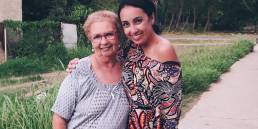Pinned to one of the bedroom walls in my 13 year old niece’s room was a vision board of all the things I wanted in the coming year. Having just moved back home to Miami on the heels of a bad breakup, I took to giving my life a makeover/break-over. Right smack in the middle of that vision board was a magazine cutout of the words Cruise to Cuba. For years I had wanted to visit my father’s patria but had always felt like it was unattainable, a far-off dream. I never felt quite entitled to visit – besides, I was only ever Cuban by way of my father so could I really call myself Cuban?
And then one fortuitous afternoon, while watching the news with my mom and pops, Noticias Univision 23 was covering a story on the CubaOne Foundation. Inspired by Birthright Israel, CubaOne brings young Cuban Americans between the ages of 22and 35 to Cuba to connect with locals and family, learn about their roots, and spark collaboration and cultural exchange.
Tired of pushing this pilgrimage onto the backburner of my life, I took this as a sign and applied that evening. Fast forward through the interview process, I found myself to be one of the seven lucky participants selected for CubaOne’s first LGBTQ focused trip this past May. Each CubaOne visit is tailored to the interests of the cohort. As an LGBTQ activist and queer woman of color, I was thrilled to celebrate International Day Against Homophobia and Transphobia in Havana.
We stayed at a casa particular in the Vedado neighborhood of Havana, where the start and end of our days blended with those of the locals. Our itinerary combined planned activities and time to visit family. We toured Old Havana with a guide from the University of Havana; visited Regla, a municipality known for its rich Afro-Cuban history and Santeria celebrations; and met with local artists and business owners who are supporting their families and building a new economy for Cuba’s future.. One such business was Clandestina, an LGBTQ owned and operated industrial design workshop that creates unique t-shirts, notebooks, and bags from recycled materials. We chatted with Idania Del Rio, the creative and entrepreneurial force behind Cuba’s first (and for now, only) design store. But perhaps one of the most impactful people-to-people connections I had during my stay happened over dinner with an LGBTQ activist with whom I am still in contact. Our conversation ran the gamut from la vida cotidiana cubana; first, second and third wave Cuban migration to the States; and living life as a queer woman of color in Cuba.
The day I was leaving to Cuba, my parents drove me to the airport to see me off. And on our way my father gave me the address of the home in which he grew up in San Miguel del Padron in Havana (a house my grandfather built). On the fifth day of the trip, those of us with family in Cuba were able to connect with them. With the help of our tour guide, I visited the childhood home of my father, which I had only seen in photos. As the driver whipped around the city in search of the address, my belly filled with anxiety and my heartbeat quickened. Would it still be there? What would it be like? As quickly as those questions popped into my mind, quickly they dissipated as we rolled down the dirt road and stopped in front of San Jose #17524 between Pedro Telles Street and Narciso. What transpired next was a mix of elation, sadness, and gratitude. Our tour guide facilitated my meeting with the current residents of my father’s childhood home as I was choking on tears and suddenly found myself unable to articulate anything in Spanish.
This was the Cuba I wanted to see: immersive, off the beaten path, authentic, and real. I couldn’t care less for the version of Cuba I had already created in my head – the amalgam of the tenuous relationship with the States, the pictures painted for me by my father and grandparents, communism and revolution. There was more to this that I was disconnected from – history books weren’t enough, college courses didn’t cut it even as a Latin American Studies major. Nothing compared to experiencing the sights, the life and the movement of the island and its people firsthand. I could go on and on about the ways in which we helped the private sector by dining exclusively at privately-owned restaurants, staying in family homes, and our innumerable taxi rides around the city–all of which plays a small, but important, role in supporting the Cuban people. But what I will forever take with me is the opportunity granted to me to come back home for my father who left everything he knew behind in 1980 never to return again.
Cuba is a paradise in contradiction. Everything and nothing at all what you think. It is an island nation with a people full of hopes and dreams for a better tomorrow. But you wouldn’t know that if you never visit it, would you? I didn’t. There’s promise for both Cubans on the island and Cuban Americans in the States, by lifting the veil of isolation and misconception. We are more alike than we are different. Sometimes it only takes one conversation, one connection. And for many young Cuban Americans, CubaOne could be that bridge.
Carla Peña
Carla is a San Francisco based community organizer working to better social services for the LGBTQ community. She traveled to Cuba with CubaOne in May of 2017.

